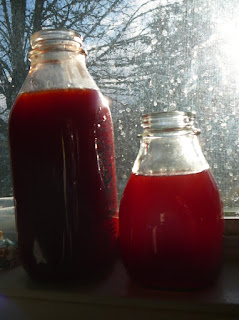In the Book of Kells, the pigment confirmed to be used as red is red lead.
Red LEAD. We're not going that.
But let's explore this pigment choice. Why didn't they just use madder?
Madder was known and grew throughout Europe. The laking process was technology easily available to monks. And madder is the truest natural red. And, perhaps as important, I grow it and really wanted to use it in something cool and interesting.
Now the Renaissance painting masters used Madder Lake, but this is not rocket science (Philosopher's Stone Level Alchemy?) even for the Middle Ages. True, of the lake colors, madder can be the fiddliest to get right, but this just takes time and honesty, what monk doesn't have loads of time?
I really didn't want to use Amazon to hunt down a safe(maybe?) form of red lead when I had madder growing in the front yard. What would a monk do? Surely they would use what they had at hand before seeking exotic and dangerous imports(to be fair, they probably had no idea how dangerous lead was). And with that excuse, a maddering I went!
Madder, or Rubia tinctoria, is the go to dye plant for true natural reds. Altering pH can alter shades, but, except maybe for purple/violet, why would you? There are many online resources to dye with madder, but few to get pigment. We're all rather stumbling around in the dark ages of the future trying to recreate the past.
Except for the top of the line pigment produced by Kremmer. But they don't count, showoffs.
Continuing to stumble around in the dark, the best resource I found was a violin forum, Maestronet . Madder lake is apparently used in traditional varnishes. Between this forum and several scientific and historical reconstruction papers, I was able to cobble together a tentative plan...
Step 1: plant madder seeds.
Step 2: wait three years.
I'm not just being cheeky. I planted my plants almost four years ago as part of the herb, medicine, dye and historical plants garden. I have dyed with madder in small batches and it is so handy to have it right out there. Ideally one digs up roots at the end of the season, though these I dug up early spring. YOu can even root up small amount in the middle of the year for test projects. And if you dye with a traditional stinky woad vat, madder helps the fermentation process. But for best results they should be allowed to grow mostly unmolested for at least three years.
After digging the roots up, I washed them thoroughly. Many sources stressed this as essential to get a good clean bright red. Of course by "wash thoroughly", I just let them sit in water for most of the day, then swished most of the dirt off. After a through rinse in the sink, I cut the roots up into small pieces, then put them in a jar filled with water and a large slash of vinegar and let them sit a week.
By that time the roots should be waterlogged and settled. One can heat them to try to extract more pigment, but one risks shifting the color to orange if the pot gets too hot. Playing it safe I stuck with the cold extraction.
I strained the liquid, removing the roots, and added the soda ash. This is different from other lakes in that alum is added first. I'm not sure if it matters, but I'm taking chances with a once a year harvest. I trust the lads( and lasses) at the violin forums know there business!
From dye pots, I know adding the soda makes the color more vivid, but the water was so dark crimson, one couldn't tell. Then I added the alum, and the color shifted, and, as lakes do started to congeal...very, very, slowly. One has to be patient, but with experience one can see when it's happening very slowly, when it's not happening, and what careful corrections one should take.
In this case, after the first panic of it either not working or turning pink(utter death for a varnish), I was pleased that not only had it worked perfectly, but I had some of the highest quality sought after crimson one could make.
After settling, it must be strained by a very fine coffee filter. Then scrapped off onto a glass or nonreactive metal surface to dry.
It dries almost black. I assume in grinding the red comes out again.
Well, looking at the abundant red left in the water, I saved to to make a second lake. That was so smart because I was able to get a stunning fire engine red.
This was very satisfying. Another lovely thing about madder dyes and pigments is they are, if not colorfast, then extremely resistant to fading. Of course nowadays alizarin, the red chemical in madder, is synthesized, a much less magical process. I'll stick to my madder patch while I have it.














No comments:
Post a Comment
Note: Only a member of this blog may post a comment.